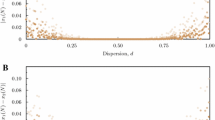Abstract
A method is presented to estimate the minimum viable metapopulation size based on the basic reproductive number R 0 and the expected time to extinction τ E for epidemiological models. We exemplify our approach with two simple deterministic metapopulation models of the patch occupancy type and then proceed to stochastic versions that permit the estimation of the minimum viable metapopulation size.
Similar content being viewed by others
References
Anderson, R.M. and R.M. May. (1991). Infectious Diseases of Humans, Oxford, Oxford Science Publications.
Bailey, N.T.J. (1975). The Mathematical Theory of Infectious Diseases and its Applications, London, Charles Griffin.
Diekman, O., J.A.P. Hesterbeek and J.A.J. Metz. (1990). On the definition and computation of the basic reproductive ratio R 0 in models for infectious diseases in heterogeneous populations. J. Math. Biol. 28, 365–382
Goodman, D. (1987). The demography of chance extinctions, in Viable Populations for Conservation. M.E. Soulé, (ed.) pp. 11–43. New York, Cambridge University Press.
Gyllenberg, M., I. Hanski and A. Hastings (1997). Structured metapopulation models. In Metapopulation Biology: Ecology, Genetics, and Evolution. I. Hanski, and M.E. Gilpin (eds), pp. 93–122. New York, Academic.
Hanski, I (1989). Metapopulation dynamics: does it help to have more of the same? Trends Ecol. Evol. 4, 113–114.
Hanski, I (1991). Single-species metapopulation dynamics: concepts, models and observation. Biol. J. Linn. Soc. 42, 17–38.
Hanski, I. and M. Gyllenberg (1993). Two general metapopulation models and the core-satellite species hypothesis. Am. Naturalist 142, 17–41.
Hanski, I., A. Moilanen and M. Gyllenberg (1996). Minimum viable metapopulation size. Am. Naturalist 147, 527–541.
Hernández-Suárez, C.M. (1997). Problems in the theory and application of models of infectious diseases. PhD Thesis, Biometrics Unit Cornell University.
Kareiva, P. and U. Wennergren (1995). Connecting landscape patterns to ecosystem and population processes. Nature, 373, 299–302.
Lande, R. (1993). Risks of population extinction from demographic and environmental stochasticity and random catastrophes. Am. Naturalist, 142, 911–927.
Lawton, J.H., S. Nee, A.J. Letcher and P.H. Harvey (1994). Animal distributions: patterns and processes, in Large Scale Ecology and Conservation Biology, P.J. Edwards, R.M. May, and N.R. Webb (eds), pp. 41–58. Oxford, Blackwell Scientific.
Levins, R. (1969). Some demographic and genetic consequences of environmental heterogeneity for biological control. Bull. Entomol. Soc. Amer., 15, 237–240.
Levins, R. (1970). Extinction. Lectures on Mathematics in the Life Sciences 2. Providence, American Mathematical Society, RI.
Marquet, P.A. and J.X. Velasco-Hernández (1997). A source-sink patch occupancy metapopulation model. Revista Chilena de Historia Natural, 70, 371–380.
Nåsell, I. (1995). The threshold concept in deterministic and stochastic models, in Epidemic Models: their Structure and Relation to Data, D. Mollison (ed.), Cambridge, Cambridge University Press.
Nee, S. (1994). How populations persist. Nature, 367, 123–124.
Nee, S. and R.M. May. (1992). Dynamics of metapopulations: habitat destruction and competitive coexistence. J. Animal Ecol. 61, 37–40.
Nee, S., R.M. May and M.P. Hassell. (1997). Two-species metapopulation models. In Metapopulation Biology: Ecology, Genetics, and Evolution, I. Hanski and M.E. Gilpin (eds), pp. 123–147. New York, Academic.
Nisbet, R. and W.S.C. Gurney (1982). Modeling Fluctuating Populations. Chichester, Wiley.
Renshaw, E. (1991). Modeling Populations in Space and Time. Cambridge, Cambridge University Press.
Richter-Dyn, N. and N.S. Goel (1972). On the extinction of a colonizing species. Theor. Pop. Biol. 3, 406–433.
Shaffer, M.L. (1981). Minimum population sizes for species conservation. BioScience, 31, 131–134.
Tilman, D. (1994). Competition and biodiversity in spatially structured habitats. Ecology, 75, 2–16.
Wissel, C. and S. Stocker (1991). Extinction of populations by random influences. Theor. Pop. Biol. 39, 315–328.
Author information
Authors and Affiliations
Corresponding author
Rights and permissions
About this article
Cite this article
Hernández-Suárez, C.M., Marquet, P.A. & Velasco-Hernández, J.X. Threshold parameters and metapopulation persistence. Bull. Math. Biol. 61, 341–353 (1999). https://doi.org/10.1006/bulm.1998.0084
Received:
Accepted:
Issue Date:
DOI: https://doi.org/10.1006/bulm.1998.0084




